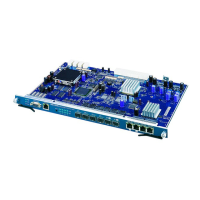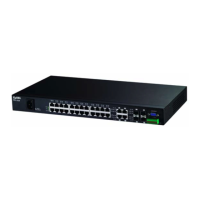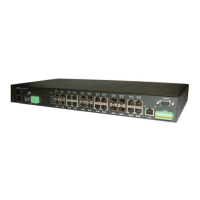Chapter 36 voip Commands
Management Switch Card User’s Guide
1096
36.20.3 voip sip numberplan set Command
Syntax:
voip sip numberplan set <name> <index> [<pattern> <rule>]
where
This command replaces the <pattern> (the dialed number) with the specified <rule>. The VoIP line
card applies the rules in numerical order, from 1 ~ 16, so ordering is important.
For example: take the pattern "002(1.)T" and rule “\1”. The “002(1.)” pattern represents “002”
followed by zero or more ones. The “\1” rule replaces the “002” with the zero or more ones. So, if a
user presses 00211111#, the VOP will dial out 11111 immediately. The command to create this
entry is as follows.
<index> =
The entry number (1 ~ 16) in the numberplan table.
<pattern> =
The dialed number for which this rule applies. Up to 48 characters. The pattern
can be a specific number or a defined pattern.
Allowed characters are:
• Numerals “0” ~ “9”
• “x” representing a digit 0 ~ 9, a “*”, or a “#”.
• Asterisk “*” (meaning just an “*”)
• Period “.” (representing zero or more repetitions of the digit or range
preceding it, for example “5.” and “[1~3].”).
• Tilde “~” (representing a range of digits, for example “[3~9]”). The tilde must
be used in brackets, and characters to either side of the tilde must both be
digits.
• Comma”,” (representing a choice of digits. for example “[4,9]”). The comma
must be used in brackets, and characters to either side of the comma must
both be digits.
• Pipe “|”, separating number plan patterns.
• Brackets “[“ and “]” (representing an allowed range, for example “[1,3~5]”).
• A maximum of one pair of parentheses “(” and “)”
• “T” if a user dials some numbers and then presses “#”, the rule will be applied
and the numbers will be dialed out at once.
<rule> =
The value with which the pattern is to be replaced.
“\c” = countrycode
“\d” = national destination (region) code
“\1” = the characters represented in the <pattern> are replaced by the
characters represented inside the parentheses “(” and “)” in the <pattern>. This
means the characters represented inside the parentheses in the <pattern> are
used in dialing the call and the rest of the characters represented by the
<pattern> are discarded.
“deny” = the <pattern> is not allowed.
ras> voip sip numberplan set example 1 002(1.)T \1

